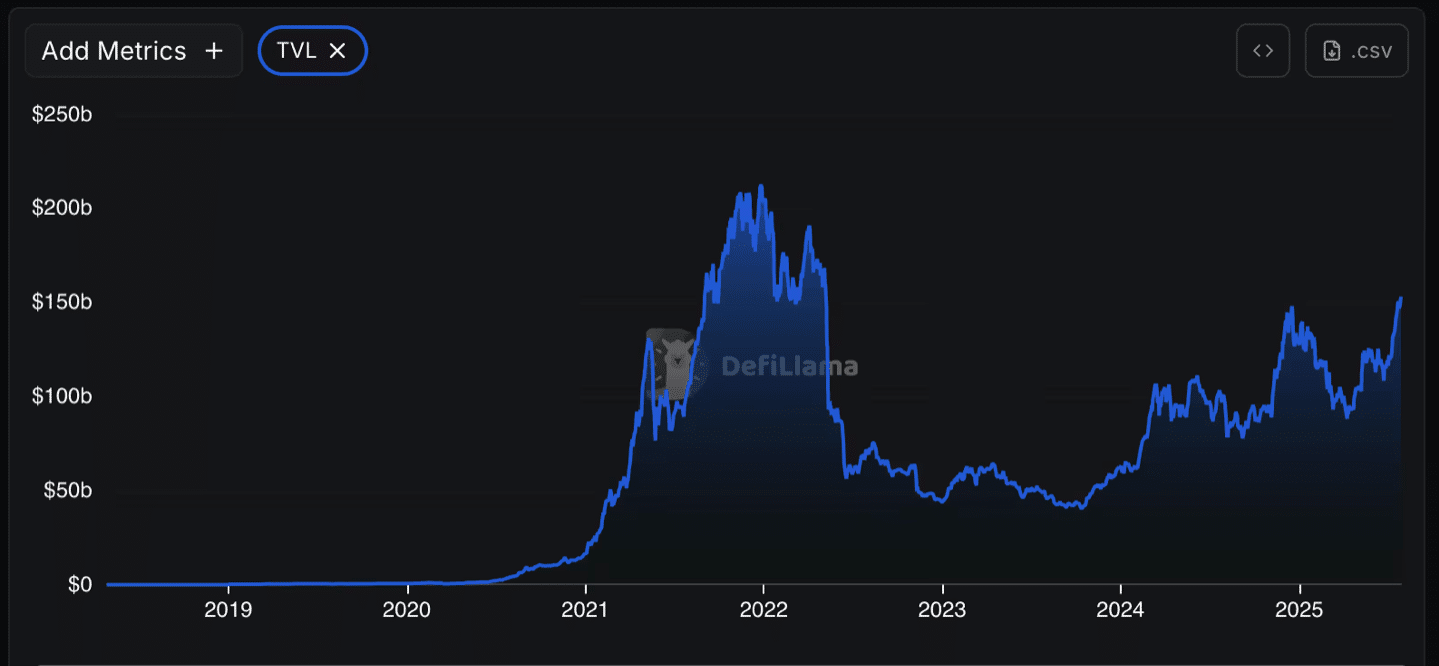According to the latest reports, DeFi has hit a 3-year high of $153 billion in total value locked (TVL), reversing the decline seen earlier in the year. Most of this growth is due to DeFi yield strategies, especially Ethereum restaking, looping on lending platforms and cross-chain expansion on Solana, Avalanche and SUI.
- Ethereum Remains Central as Institutional and Retail Yields Rise
- How DeFi Yield Strategies Are Changing TVL Dynamics
- Broader Implications and Emerging Risks
- Conclusion
- FAQs
- What drove DeFi TVL to a 3 year high?
- How big is Ethereum in the current landscape?
- What are yield driven looping strategies?
- What cross chain growth trends are emerging?
- Are there risks with rising TVL?
- Glossary
Ethereum is leading the charge, accounting for 60% of all DeFi TVL, mostly through Lido and Aave, each with $32-34 billion in locked assets. Most of this capital is flowing through liquid staking and lending ecosystems, showing structural growth and sector resilience.
Ethereum Remains Central as Institutional and Retail Yields Rise
Over the last month, Ethereum’s price has gone up 60%, from $2,423 to rise above $3,880, driven by institutional capital flow and large treasury moves, including Sharplink Gaming’s $1.3 billion ETH purchase and BitMine’s $2 billion strategy deployment.

Yield structures on Ethereum have moved beyond simple staking (1.5-4% APY). Advanced DeFi yield strategies like restaking and looping (circulating stablecoins between Euler and Spark) are reportedly generating 25% annual yields with liquidity intact. These tactics are attracting both retail and institutional liquidity providers.
Cross-chain DeFi ecosystems are also seeing strong growth: Solana TVL has grown 23% to $12 billion, Avalanche and SUI have grown TVL 33% and 39% respectively, while Bitcoin DeFi has grown 9% to $6.2 billion.
How DeFi Yield Strategies Are Changing TVL Dynamics
DeFi is no longer just staking and lending. Liquid staking platforms like Lido, along with restaking pioneers like EigenLayer, are now core pillars of investor returns and protocol growth.
Restaking allows you to stake your ETH across multiple security protocols at the same time, while stablecoin looping between Euler and Spark can stack mining incentives, boosting APR when done right. These DeFi yield strategies are especially popular when native yields are low and liquidity is flexible.
But experts warn that some protocols may be inflating TVL numbers with leveraged or wrapped assets which can increase risk and hide true capital flows.
Broader Implications and Emerging Risks
The return of DeFi yield strategies means on-chain finance has matured, attracting institutional capital and giving DeFi a reputation beyond speculative cycles. Higher TVL and yield innovation is being compared to traditional bank-like performance, but with DeFi’s transparency and composability.

However risks remain. DeFi TVL is 30% below the November 2021 peak and concerns around asset double counting, liquidation cascades and protocol vulnerabilities persist. TVL can misrepresent exposure when leveraged positions inflate the numbers.
But many think the combination of strong token incentives, regulatory clarity and infrastructure development will keep the momentum going well.
Conclusion
Based on the latest research, DeFi TVL is at a 3-year high of $153 billion. Ethereum is still leading, with liquid staking, restaking and looping strategies offering competitive yields. Cross-chain expansion on Solana, Avalanche, and Sui is diversifying the DeFi landscape.
Downside risk is still there through scaling mispricing or incentive shifts, but overall outlook is positive. If growth continues, DeFi TVL could get to $170 billion, but if yields or investor appetite falter,it could drop to $120 billion.
For in-depth analysis and the latest trends in the crypto space, our team offers expert content regularly.
Summary
DeFi TVL is at $153 billion, the highest since May 2022. Ethereum protocols (Lido and Aave) have 60% of TVL, with institutional investment and DeFi yield strategies like restaking and stablecoin looping offering up to 25% APR. Cross chain ecosystems on Solana, Avalanche and Sui are growing double digits.
FAQs
What drove DeFi TVL to a 3 year high?
Ethereum price increase, institutional inflow and DeFi yield strategies like restaking and looping.
How big is Ethereum in the current landscape?
Ethereum is 60% of all DeFi TVL, Lido and Aave are around $32–34 billion each.
What are yield driven looping strategies?
Users supply stablecoins (e.g. USDC) to Euler, borrow sUSDC, resupply it and repeat via Spark incentives to compound yield—up to ~25% APY.
What cross chain growth trends are emerging?
Solana, Avalanche and Sui have 20–40% TVL growth, diversifying the DeFi landscape.
Are there risks with rising TVL?
Yes—TVL can be inflated by bundled or leveraged positions and restaked assets can increase liquidation risk under stress. TVL is still below the previous high.
Glossary
DeFi yield strategies – Complex ways to maximize returns in DeFi, restaking, looping stablecoins across protocols.
TVL (Total Value Locked) – Total assets in DeFi protocols, measure of sector growth and user trust.
Restaking – Re-staking staked ETH to multiple blockchain protocols at the same time.
Looping – Borrowing and resupplying stable assets to compound protocol rewards.
Double counting – Overstating capital through wrapped or leveraged positions that can distort TVL numbers.



















































































































